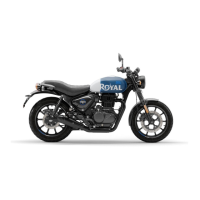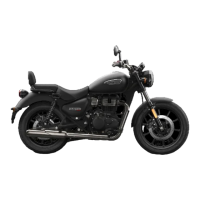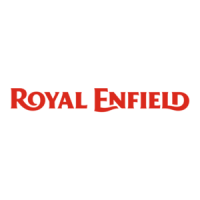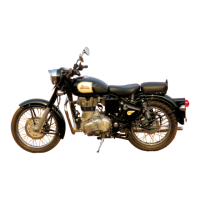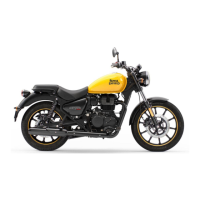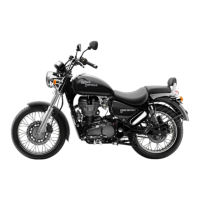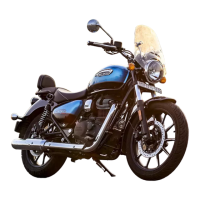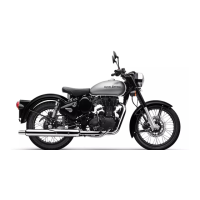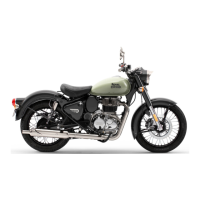Do you have a question about the Royal Enfield Classic 350 and is the answer not in the manual?
Prepare for riding by reading manual, checking controls, and knowing road rules.
Follow guidelines for safe refueling, including engine off and ventilation.
Operate new motorcycle according to running-in procedure and moderate speeds.
Adhere to speed limits and adjust for road/weather conditions.
Be aware of surroundings, ride defensively, and use proper gear.
Recognize road hazards and forces that can affect motorcycle stability.
Ensure passenger safety, perform maintenance, and be aware of system hazards.
Handle batteries, avoid towing, and consult service centers for issues.
Ensure number plate visibility and ride at appropriate speeds for road surfaces.
Maintain lane position and use signals cautiously when overtaking.
Follow right-of-way rules at intersections and adhere to general road rules.
Obey traffic signs, signal turns, and never jump traffic lights.
Park on stable surfaces and secure the motorcycle against theft.
Motorcycle has convex mirrors for wider rear view; adjust mirrors carefully.
Use genuine accessories for performance; rider is responsible for safe operation.
Concentrate luggage low, distribute evenly, and ensure security.
Large surfaces and non-standard parts can affect handling; use model-specific accessories.
Avoid incorrect installation and ignore model/design specifications.
Understand weight limits and the impact of payload on handling and stopping.
Details on engine type, bore, stroke, capacity, compression, power, torque, RPM.
Details on ignition type, spark plug gap, and spark plug.
Details on clutch, drive, gearbox, gear ratios, final drive.
Details on frame, suspension, brakes, and ABS.
Specifications for front and rear tyre make and size.
Tyre pressure for solo/pillion, fuel type, capacity, octane rating.
Details on generation, battery, starter, lamps, horn, and charger port.
Motorcycle length, width, wheelbase, ground clearance, saddle height, kerb/gross weight.
Recommended grades and capacities for engine oil, fork oil, and brake fluid.
Explains the 17-digit VIN and its components.
Identifies the location of VIN and noise labels on the motorcycle.
Identifies the location of emission labels on the motorcycle.
Identifies controls on the handlebar: fuel cap, switches, levers, buttons.
Identifies components on the right side: trafficator, wheel, starter, brake pedal, horn.
Identifies components on the left side: trafficator, pedal, stand, panels, fuel tank.
Operation of ignition switch and steering lock mechanism.
Instructions for opening and locking the fuel tank cap.
Warnings on fuel filling and identification of fuel tank parts.
How to use the engine stop and electric start switches.
Turn off ignition key to avoid battery discharge during prolonged storage.
Identifies all parts and indicators on the instrument cluster.
Explanation of fuel gauge, service reminder, and ECO mode displays.
Guide to using the info button for trip meter functions and sequence.
Details on Trip F functionality and fuel indication accuracy.
Step-by-step guide to setting the clock using the info button.
Introduction to the Tripper navigation system and its features.
Location, usage, and warnings for the USB charger port.
Explains how ABS prevents wheel locking and improves traction.
Describes the ABS indicator lamp and its function.
Cautions regarding ABS as a supplement, not substitute, for good riding.
Instrument cluster is integral to ABS; apply both brakes simultaneously.
Warnings on using approved tyres/sprockets, suspension changes, and spare parts.
Inspect ABS tone rings for damage and debris.
Do's and Don'ts for ABS operation, including checking indicator and brake fluid.
Explains how the roll over sensor disables systems and how to reset it.
Checklist for fuel, tyres, chain, brakes, steering, throttle, cables, fluid, and clutch.
Procedure essential for bedding-in parts and achieving optimum performance.
Table of recommended maximum speeds for the first 2000 km.
Procedure for shifting to neutral and turning on ignition and kill switch.
MIL indicator glows briefly on startup, indicating normal EFI function.
Check for malfunction indicator; refuel if low fuel bar is blinking.
Disengage clutch and use electric start switch until engine starts.
Notes on starter switch use and precautions for side stand cut-off.
Cautions regarding prolonged starter use and engine warm-up.
Accelerate after idling stabilizes; ensure side stand is retracted.
Caution against shifting gears without moving the motorcycle back and forth.
Depress clutch lever and use starter button within limits; allow battery recovery.
Warm up engine; understand the gear shift pattern.
Procedures for engaging gears and caution on clutch use.
Procedures for engaging gears and downshifting.
Start in neutral, move in first gear, and downshift when slowing.
Chart showing recommended vehicle speeds for up and down shifts.
Cautions against abrupt clutch release or insufficient throttle opening.
Exercise caution releasing clutch; shift to neutral before stopping.
Steps for parking on the center stand: select surface, straighten bar, lower stand.
Steps for parking on side stand: select surface, lower stand, tilt gently.
Lists items included in the tool kit with descriptions and quantities.
Lubricate control cables and pivots for levers and stands.
Steps for checking engine oil level: ensure center stand, idle, wait, check level.
Cautions on using wrong oil grade, checking in cold, sitting on vehicle, overfilling.
Clean and lubricate drive chain, wipe excess lubricant.
Steps for adjusting drive chain tension to 25-30mm.
Remove, clean, and set electrode gap for spark plug.
How to check front and rear brake fluid levels.
Cautions about brake fluid being corrosive and not mixing Dot 4.
Notes on cleaning filler cap, using specified fluid, and warnings about insufficient/old fluid.
Inspect tyres for wear, cracks, cuts; check for embedded particles.
Warnings on correct tyre pressure and using recommended tyre specifications.
Check brake pads for wear against the indicator; replace if worn.
Motorcycle has 12V-8Ah VRLA battery; check terminals periodically.
Cautions on poor contact, loose fitments, and battery cable disconnection order.
Clean wire terminals, coat with petroleum jelly, ensure cable connections are firm.
How to adjust headlight beam vertically using an adjusting screw.
Fuse and fuse carrier located in RH side cover.
Diagram showing the layout of EMS fuses.
List of fuse IDs, colors, ratings, and remarks for various systems.
Warning about getting electrical system checked after fuse failure.
Steps for adjusting rear shock preload using a C-spanner.
Use C-spanner; best setting depends on rider/luggage weight.
Chart for unladen/laden conditions, showing setting notch and tyre pressure.
Service, fuel, tyre pressure, clutch free play checks before starting.
Checks for fasteners, tyres, oil, lights, horn, chain, clutch.
List of essential items to carry on a long trip.
Remove key, toolkit, cover parts; wash when cold.
Clean engine area with solvent; use low-pressure water, avoid sensitive parts.
Use detergent, clean with water; use compressed air to dry.
Wash with cold water in salty areas; apply anti-corrosion spray.
Ensure motorcycle is dry; remove tapes, lubricate, polish.
Service, drain fuel, add oil, clean chain, remove fuse, store battery.
Tips to keep riding places unspoilt.
Proper disposal of engine oil and batteries via recycling agents.
Hand over replaced parts and cleaning solvents for environmentally friendly disposal.
Schedule based on average riding conditions; frequency may shorten in severe environments.
Schedule for engine oil level check/replace, filter element, and oil strainer.
Schedule for tappets, hoses, spark plugs, and air filter.
Schedule for starter, battery, fuel filter, and fork oil.
Schedule for steering ball races and wheel rim run out checks.
Schedule for swing arm, tyre wear, and drive chain.
Schedule for cush drive rubbers and brake hose/banjo bolt.
Schedule for lubricating levers, cables, pivots, and switches.
Schedule for checking brake pads and cleaning the throttle body.
Warranty is valid for 36 months from the first date of sale.
Maintenance schedule must be followed at authorized facilities for warranty.
Proof of service history is required for warranty verification.
Proof of ownership with engine/VIN numbers must be provided.
Obligation limited to repair/replace defective parts.
Costs for consumables, labor, shipping are chargeable.
Lists parts not covered: normal ageing, wear and tear, electrical items.
Conditions that void warranty: lack of maintenance, unauthorized repairs, accidents.
RE decides claims; can change models without prior notice.
Distributors are independent; RE not liable for aftermarket products or damages.
Explains emission control system warranty for California vehicles.
Coverage period for emission parts: 5 years or 30,000 km.
Owner responsible for required maintenance; retain receipts.
Present motorcycle to dealer promptly; repairs within 30 days.
Warranty denied for abuse, neglect, improper maintenance, unapproved modifications.
Warranty starts on delivery; uses genuine parts for compliance.
Reimbursement for emergency repairs if covered and approved.
Lists specific 'warranted parts' of the emission control system.
Lists conditions/parts not covered by emission warranty.
Warranty for noise control system, conforming to EPA/CARB regulations.
Lists items not covered: misuse, alterations, non-genuine parts, odometer tampering.
Recommended routine maintenance by authorized dealers using genuine parts.
Warranty for evaporative system, conforming to regulations, period 24 months.
Lists items not covered: misuse, alterations, non-genuine parts.
Recommended routine maintenance by authorized dealers using genuine parts.
Recommended to perform wiring repair only by authorized service center.
FCC and ISED compliance information for the Tripper unit.
| Engine Type | Single Cylinder, 4 Stroke, Air-Oil Cooled |
|---|---|
| Max Torque | 27 Nm @ 4000 rpm |
| Fuel System | Electronic Fuel Injection |
| Transmission | 5-speed Constant Mesh |
| Front Suspension | Telescopic, 41mm forks, 130mm travel |
| Rear Suspension | Twin tube emulsion shock absorbers with 6-step adjustable preload |
| Kerb Weight | 195 kg |
| Seat Height | 805 mm |
| Ground Clearance | 170 mm |
| Wheelbase | 1390 mm |
| Front Brake | Single 300mm disc, twin-piston floating caliper |
| Rear Brake | Disc, 270 mm |
| Fuel Tank Capacity | 13 liters |
| Max Power | 20.2 bhp @ 6100 rpm |
